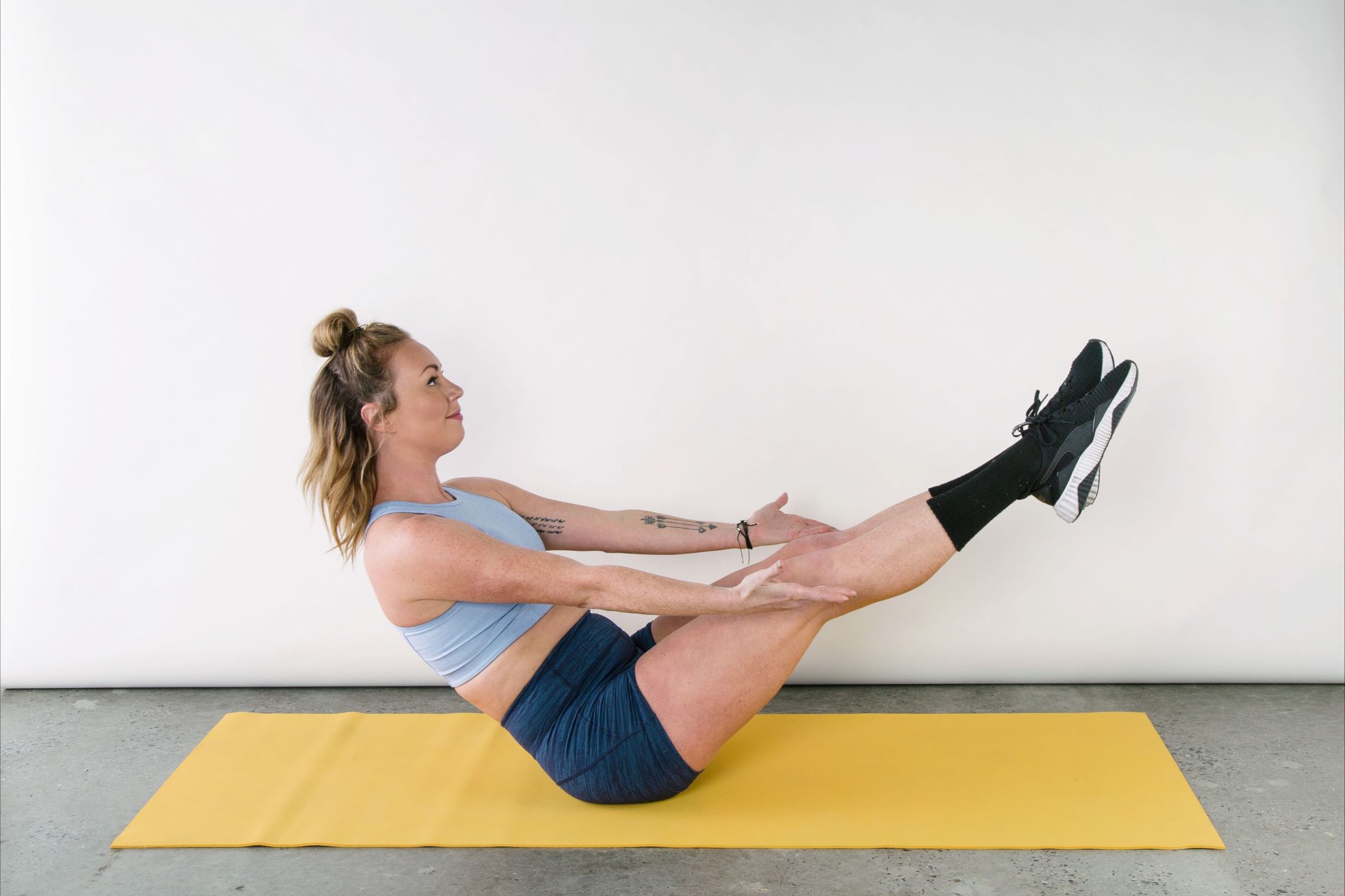Home>Misc>Featured>Why Is It Important To Assess Flexibility Both Before And During A Workout Regimen


Featured
Why Is It Important To Assess Flexibility Both Before And During A Workout Regimen
Modified: August 19, 2023
Discover the importance of assessing flexibility before and during your workout regimen. Learn how to improve and optimize your fitness journey. Featured topic.
Introduction
Welcome to the world of fitness and exercise! Whether you are a seasoned gym-goer or just starting your fitness journey, it is crucial to understand the importance of assessing flexibility both before and during a workout regimen. Flexibility plays a critical role in overall physical fitness and joint health, and its assessment provides invaluable insights into an individual’s range of motion and muscle flexibility.
Flexibility refers to the ability of muscles and joints to move through a full range of motion. It is an essential component of functional fitness and contributes to improved performance, reduced risk of injury, and enhanced recovery. As we age, our flexibility tends to decrease, making it even more crucial to incorporate flexibility assessments into our workout routines.
Assessing flexibility before starting a workout regimen helps establish a baseline and allows individuals to identify tight or inflexible areas that could hinder their performance or increase the risk of injury. It provides a benchmark to track progress and make necessary adjustments to training programs. Similarly, assessing flexibility during a workout regimen allows for ongoing evaluation and ensures that individuals are optimizing their flexibility potential.
Flexibility assessments are not just for professional athletes or fitness enthusiasts. They are beneficial for individuals of all fitness levels and ages as they provide a better understanding of the body’s limitations and areas that require attention. By identifying areas of limited flexibility, individuals can tailor their workouts and incorporate exercises specifically targeting those areas, thus promoting balanced muscle development and reducing the risk of imbalances or overuse injuries.
In the following sections, we will explore the various benefits of assessing flexibility both before and during a workout regimen. We will also discuss the different methods, tools, and techniques used to evaluate flexibility. By the end, you will have a comprehensive understanding of how flexibility assessments can significantly improve your workout routine and overall fitness.
Importance of Assessing Flexibility
Assessing flexibility is essential for several reasons. It provides valuable information about an individual’s range of motion, muscle imbalances, and potential areas of weakness. By understanding these factors, individuals can customize their workout regimens to target specific areas and prevent injuries.
One of the primary reasons to assess flexibility is to identify any existing muscle imbalances. Muscle imbalances occur when certain muscles become tight and overactive, while others remain weak and underactive. These imbalances can lead to poor posture, decreased athletic performance, and an increased risk of injuries. By assessing flexibility, individuals can pinpoint these imbalances and implement corrective exercises to restore balance and prevent further dysfunction.
Assessing flexibility also allows individuals to evaluate their range of motion. Range of motion refers to the extent to which a joint can move through a specific movement pattern. Limited range of motion can impair functional movements and hinder performance in activities such as squatting, bending, or reaching. By identifying limitations in range of motion, individuals can focus on improving flexibility in those specific areas, leading to enhanced mobility and better overall body mechanics.
Moreover, flexibility assessments can highlight potential areas of weakness or lack of flexibility. These weak areas can serve as a breeding ground for injuries. By identifying these vulnerabilities, individuals can incorporate targeted stretching exercises and mobility drills to address those areas and prevent injuries from occurring. Additionally, addressing weaknesses in flexibility can also improve performance in activities requiring a higher range of motion, such as dancing, yoga, or martial arts.
Regular flexibility assessments offer the opportunity to track progress and make adjustments to training programs. As individuals engage in consistent exercise and flexibility training, they can monitor their improvements and identify areas that still require attention. This feedback loop allows for more effective progression, ensuring that training programs continue to challenge the body while maintaining optimal flexibility.
Overall, assessing flexibility is vital for optimizing performance, preventing injuries, and maintaining overall joint health. It provides valuable insights into an individual’s range of motion, muscle imbalances, and weaknesses. By incorporating flexibility assessments into your workout regimen, you can create a more well-rounded and effective training program that promotes balanced muscle development, enhances mobility, and reduces the risk of injuries.
Benefits of Flexibility Assessment Before a Workout Regimen
Flexibility assessment before starting a workout regimen offers a multitude of benefits that can significantly impact your training effectiveness and overall fitness journey. Let’s explore some of the key advantages:
1. Establishing a Baseline: By assessing flexibility before starting a workout regimen, you can establish a baseline measurement of your current range of motion and muscle flexibility. This baseline provides a starting point for tracking your progress over time and allows you to set realistic goals for improving flexibility.
2. Identifying Tight or Inflexible Areas: Flexibility assessment helps to identify specific tight or inflexible muscle groups or joints in your body. These tight areas can limit your range of motion and increase the risk of injury during workouts. By pinpointing these areas, you can tailor your workouts to focus on stretching and mobilizing those specific muscle groups, improving overall flexibility, and reducing the likelihood of injuries.
3. Customizing Your Workout: Understanding your flexibility limitations can help you customize your workout regimen to target areas that need attention. By incorporating specific exercises and stretches to address your tight or inflexible areas, you can improve muscle balance, enhance movement patterns, and optimize your performance.
4. Preventing Injuries: Flexibility assessment before a workout regimen allows you to identify potential areas of weakness or poor range of motion that may put you at a higher risk of injuries. By addressing these vulnerabilities through targeted stretching and mobility exercises, you can strengthen and improve the flexibility in those areas, reducing the likelihood of injuries during your workouts.
5. Enhancing Performance: Improved flexibility can have a direct impact on your athletic performance. By increasing your range of motion, you can enhance your ability to perform exercises with proper form and technique. This can lead to improved strength, better balance, and increased efficiency in movement, allowing you to maximize the benefits of your workout regimen.
6. Monitoring Progress: Regular flexibility assessments allow you to track your progress over time. By reevaluating your flexibility at regular intervals, you can see how your flexibility has improved as a result of your dedicated stretching and mobility efforts. This feedback loop helps you stay motivated and provides a sense of accomplishment as you witness your flexibility improving.
Incorporating flexibility assessment before a workout regimen provides valuable insights into your body’s limitations, weaknesses, and areas that require attention. By using this information to customize your workouts, you can prevent injuries, enhance performance, and work towards achieving your fitness goals more efficiently.
Benefits of Flexibility Assessment During a Workout Regimen
Flexibility assessment is not a one-time event, but an ongoing process that should be incorporated into your workout regimen. Continuously assessing your flexibility during your workouts offers numerous benefits that can enhance your training outcomes. Let’s explore some of these advantages:
1. Real-Time Progress Tracking: Assessing your flexibility during a workout regimen allows you to monitor your progress in real-time. By regularly evaluating your range of motion and muscle flexibility, you can gauge the effectiveness of your stretching and mobility exercises. This feedback helps you make adjustments to your routine and ensure you’re on the right track towards improving flexibility.
2. Adjusting Intensity and Duration: Flexibility assessments provide insights into how your body is responding to your workout regimen. If you notice specific areas becoming more flexible, you can adjust the intensity and duration of your stretching and mobility exercises accordingly. Likewise, if certain muscles or joints remain tight or inflexible, you can focus more attention on these areas to facilitate further progress.
3. Injury Prevention and Risk Management: Regular flexibility assessment during your workout regimen allows you to identify any potential changes or issues with your range of motion. Catching limitations or decreased flexibility early on enables you to take proactive measures to prevent injuries or address any imbalances that may arise. By addressing these concerns promptly, you can minimize the risk of developing more significant issues that could hinder your progress.
4. Form Correction: Flexibility assessment during your workouts provides an opportunity to evaluate your form and technique. When performing exercises, deviations from proper form can limit your range of motion and hinder your progress. By assessing your flexibility in real-time, you can identify areas where poor form or technique may be affecting your flexibility and make the necessary adjustments to maintain correct alignment and range of motion.
5. Motivation and Accountability: Continuing to assess your flexibility during your workouts offers motivation and accountability. Observing improvements in flexibility can serve as a positive reinforcement, encouraging you to stay committed to your stretching and mobility routine. Moreover, regularly assessing your flexibility holds you accountable to your goals, ensuring you are consistently working towards enhancing flexibility.
6. Targeted Progression: Flexibility assessments allow you to identify areas that require additional attention or progression. By evaluating your flexibility regularly, you can determine if you need to increase the difficulty or intensity of your stretching and mobility exercises. This targeted progression ensures that you continue to challenge your muscles and maintain a steady improvement in flexibility.
Flexibility assessment during a workout regimen provides valuable feedback, allowing you to monitor progress, adjust your routine, prevent injuries, correct form, stay motivated, and target areas that require additional attention. By integrating flexibility assessments into your regular workouts, you can optimize your training outcomes and achieve greater flexibility and overall fitness.
Methods and Tools for Assessing Flexibility
There are various methods and tools available for assessing flexibility, each offering a unique approach to evaluate range of motion and muscle flexibility. Let’s explore some of the commonly used techniques:
1. Active Range of Motion (AROM): AROM is a basic method to assess flexibility that involves actively moving a joint through its full range of motion. This method allows individuals to evaluate their own range of motion without the need for specialized equipment. It is commonly used for joints such as the shoulders, hips, and knees.
2. Passive Range of Motion (PROM): PROM involves moving a joint through its full range of motion with the assistance of a partner or therapist. This method allows for a more accurate assessment of flexibility as it eliminates the effects of muscle tension and strength. It is particularly useful for assessing flexibility in joints where AROM may be limited.
3. Goniometry: Goniometry is a precise method of measuring joint angles using a goniometer, a specialized tool with a protractor-like design. Goniometry provides objective measurements of joint range of motion and is commonly used in clinical settings and rehabilitation programs.
4. Flexibility Testing Kits: Flexibility testing kits are commercially available tools that provide standardized methods for assessing flexibility. These kits typically include tools such as inclinometers, flexibility rulers, and measuring tapes to measure joint angles and range of motion accurately.
5. Sit-and-Reach Test: The sit-and-reach test is a common tool used to assess hamstring and lower back flexibility. It involves reaching forward while sitting with legs extended, and the distance reached serves as an indicator of flexibility. Fitness professionals often use this test to evaluate overall lower body flexibility.
6. Functional Movement Screens (FMS): FMS is a comprehensive system that assesses multiple aspects of movement, including flexibility. It involves a series of standardized movement tests performed to identify limitations in mobility, stability, and flexibility. FMS is commonly used by fitness professionals and trainers to assess movement quality and identify potential areas of dysfunction.
7. Video Analysis: Video analysis is an increasingly popular method used to assess flexibility. By recording and analyzing movements and stretches, individuals can visually identify limitations in range of motion or detect improper form. This method allows for self-assessment and provides valuable feedback for improving flexibility.
8. Functional Flexibility Assessments: Functional flexibility assessments involve performing dynamic movements that mimic real-life activities. These assessments evaluate flexibility within the context of functional movements and are useful for athletes and individuals looking to improve flexibility specific to their sport or daily activities.
It is important to note that when performing flexibility assessments, it is essential to follow proper protocols and techniques to ensure accurate results. Additionally, it is beneficial to seek guidance from a qualified fitness professional or physical therapist to ensure proper evaluation and interpretation of the assessment outcomes.
By utilizing these methods and tools for assessing flexibility, individuals can gain valuable insights into their range of motion, identify limitations, and tailor their workouts to improve flexibility effectively.
Common Flexibility Assessment Techniques
Flexibility assessment techniques provide valuable information about an individual’s range of motion and muscle flexibility. Here are some commonly used assessment techniques:
1. Sit-and-Reach Test: The sit-and-reach test is a popular method for assessing hamstring and lower back flexibility. It involves sitting on the floor with legs extended and reaching forward as far as possible. The distance reached is measured to determine the level of flexibility in those areas.
2. Shoulder Flexibility Test: The shoulder flexibility test is used to evaluate the flexibility of the shoulder joint. It involves reaching one arm over the shoulder and the other arm behind the back. The distance between the hands is measured to assess shoulder flexibility.
3. Trunk Rotation Test: The trunk rotation test is used to assess the flexibility of the spine and torso. It involves measuring the degrees of rotation as an individual twists their upper body from side to side. This test helps identify limitations in spinal mobility.
4. Hip Flexor Test: The hip flexor test assesses the flexibility of the hip flexor muscles. It involves kneeling with one knee on the ground and the other foot positioned forward. The distance between the knee and the wall is measured to determine hip flexor tightness.
5. Ankle Dorsiflexion Test: The ankle dorsiflexion test measures the flexibility of the ankle joint. It involves placing the foot against a wall or elevated surface and moving the knee forward. The angle between the tibia and the foot is measured to assess ankle dorsiflexion range of motion.
6. Quadriceps Flexibility Test: The quadriceps flexibility test is used to assess the flexibility of the quadriceps muscles. It involves bending the knee and attempting to touch the buttocks with the heel. The ability to reach the heel to the buttocks indicates quadriceps flexibility.
7. Hamstring Flexibility Test: The hamstring flexibility test evaluates the flexibility of the hamstring muscles. It typically involves performing a straight leg raise while lying on the back or seated. The angle at which the leg can be raised without bending the knee is measured to assess hamstring flexibility.
8. Spinal Flexion and Extension Test: The spinal flexion and extension test evaluate the flexibility of the spine. It involves measuring the distance an individual can bend forward (flexion) or backward (extension) from a standing position. This test helps identify limitations in spinal mobility.
9. Calf Stretch Test: The calf stretch test assesses the flexibility of the calf muscles. It involves standing with one foot in front of the other, bending the front knee, and pushing the back heel towards the ground. The range of motion and discomfort felt during the stretch are evaluated to determine calf muscle flexibility.
10. Modified Hurdler’s Stretch Test: The modified hurdler’s stretch test is used to assess the flexibility of the adductor muscles of the inner thigh. It involves sitting on the ground with one leg extended and the other leg bent with the foot against the inner thigh. The ability to reach forward towards the extended leg indicates adductor muscle flexibility.
These flexibility assessment techniques provide valuable information about an individual’s range of motion and muscle flexibility. When conducting these tests, it is essential to follow proper protocols and techniques to ensure accurate results. It is also beneficial to consult with a qualified fitness professional or physical therapist to guide you through the assessment process and interpret the results effectively.
Factors to Consider During Flexibility Assessment
When conducting flexibility assessments, there are several factors to consider that can influence the results and interpretation of the assessment. It is important to take these factors into account to ensure accurate and meaningful assessment outcomes. Let’s explore some crucial factors to consider during flexibility assessment:
1. Individual Variability: Each person has a unique body structure, joint alignment, and muscular composition, resulting in variations in flexibility. It is important to consider individual differences when interpreting flexibility assessment results. Some individuals may naturally possess greater flexibility, while others may have inherent limitations in certain areas.
2. Age and Gender: Both age and gender can have an impact on flexibility. Generally, children and adolescents tend to be more flexible than adults due to their growing bones and muscles. As individuals age, flexibility typically decreases. Moreover, research suggests that females tend to be more flexible than males, particularly in certain areas such as hip and shoulder flexibility.
3. Warm-Up: A proper warm-up is essential before conducting flexibility assessments. It helps increase blood flow to the muscles, raise body temperature, and facilitate muscle elasticity. Failing to warm up adequately may result in temporarily decreased flexibility and inaccurate assessment outcomes. Including dynamic movements and light stretching specific to the muscles being assessed can help prepare the body for accurate flexibility assessment.
4. Pain and Discomfort: During flexibility assessments, it is crucial to differentiate between discomfort and actual pain. Discomfort can be a normal sensation during stretching, but acute pain may indicate potential injury or underlying issues. Individuals should communicate any pain experienced during the assessment to ensure appropriate modifications or alternatives can be provided.
5. Body Awareness and Relaxation: Being mindful and maintaining relaxation during flexibility assessments is crucial. Tension or resistance in the muscles can lead to inaccurate assessment results. Encourage individuals being assessed to focus on the muscles being targeted, breathe deeply, and consciously relax those muscles to achieve more accurate flexibility measurement.
6. Timing and Consistency: Flexibility can vary throughout the day and between different days. Factors such as hydration, fatigue, and recent physical activity can influence flexibility. It is important to perform flexibility assessments at consistent times, preferably when the body is well-hydrated, rested, and not immediately after intense exercise that may temporarily reduce flexibility.
7. Range of Motion vs. Flexibility: It is important to understand that range of motion and flexibility are not synonymous. Range of motion refers to the extent a joint can move within its anatomical limits, while flexibility refers to the ability of muscles and connective tissues to lengthen and stretch. Assessing both range of motion and muscle flexibility provides a more comprehensive understanding of an individual’s flexibility profile.
8. Structural Limitations: Certain anatomical factors, such as bone structure and joint shape, can inherently limit flexibility. For example, individuals with hip impingement may have limited hip joint flexibility despite having adequate muscle flexibility. Understanding these structural limitations helps in setting realistic flexibility goals and avoiding unnecessary frustration.
Considering these factors during flexibility assessments helps ensure accurate and meaningful results. It is advisable to consult with a qualified fitness professional or physical therapist for guidance in conducting flexibility assessments and interpreting the findings correctly.
Safety Precautions during Flexibility Assessment
Flexibility assessments are valuable tools for evaluating range of motion and muscle flexibility. However, it is essential to prioritize safety during the assessment process to prevent injuries and ensure a positive experience. Here are some safety precautions to consider when conducting flexibility assessments:
1. Proper Warm-up: Before conducting flexibility assessments, ensure that the individual being assessed has warmed up adequately. A proper warm-up helps increase blood flow to the muscles, raise body temperature, and prepare the body for stretching exercises. Including dynamic movements and light stretching specific to the muscles being assessed can help prevent potential injuries and discomfort.
2. Modify or Avoid Painful Movements: Pain during flexibility assessments is a sign of potential injury or discomfort. It is important to modify or avoid movements that cause pain. Encourage the individual being assessed to communicate any pain experienced during the assessment. Modify the assessment by adjusting the range of motion or finding alternative stretches to ensure safety and prevent further injury.
3. Use Proper Technique: Demonstrating and instructing the correct technique during flexibility assessments is vital to ensure proper execution. Ensure that the individual being assessed understands and uses the correct form and alignment for each assessment. Improper technique can increase the risk of strain, sprain, or other injuries, and may also lead to inaccurate assessment results.
4. Gradual Progression: Flexibility assessments should progress gradually to allow the body to adapt and avoid overstretching or overloading the muscles and connective tissues. Avoid forcing or pushing the body beyond its natural limits to prevent strain or injury. Gradually increase the intensity and duration of stretching exercises over time based on the individual’s comfort level and progress.
5. Respect Individual Abilities: Each individual has unique flexibility capabilities, and it is important to respect their limitations. Encourage the individual being assessed to stretch to a comfortable, tolerable level without pushing past their limits. Avoid comparing their flexibility to others and emphasize that the focus should be on their own progress and personal goals.
6. Use Props and Support: Utilize props and additional support, such as straps, blocks, or bolsters, to assist in maintaining proper alignment and prevent overstretching. These props can help individuals reach a comfortable range of motion while minimizing the risk of strain or injury. Properly using props can enhance safety during flexibility assessments.
7. Communication and Feedback: Regular communication with the individual being assessed is crucial to ensure their comfort and safety. Encourage them to provide feedback about any discomfort, pain, or concerns during the assessment. Adjust the assessment as needed to accommodate their needs and prevent any potential injury or discomfort.
8. Qualified Supervision: Seek the guidance of a qualified fitness professional or physical therapist who can provide proper supervision and guidance during flexibility assessments. Their expertise will ensure accurate assessments and help maintain safety throughout the process. They can also provide modifications, adaptations, and personalized recommendations based on an individual’s specific needs and limitations.
By implementing these safety precautions, you can ensure a safe and effective flexibility assessment experience. Prioritizing safety during the assessment process is essential for preventing injuries and enabling individuals to achieve their flexibility goals in a healthy and sustainable manner.
Conclusion
Assessing flexibility both before and during a workout regimen is a vital component of any fitness journey. It provides valuable insights into an individual’s range of motion, muscle imbalances, and weaknesses, allowing for targeted training and injury prevention. By understanding the importance of flexibility assessments, individuals can optimize their workout routines and achieve better overall fitness outcomes.
Before starting a workout regimen, flexibility assessments help establish a baseline and identify areas of limited flexibility that may hinder performance or increase the risk of injury. These assessments allow for customized workouts that target specific areas, promote balanced muscle development, and reduce the risk of imbalances or overuse injuries.
During a workout regimen, flexibility assessments provide ongoing evaluation and ensure that individuals are maximizing their flexibility potential. Real-time progress tracking, adjusting intensity and duration, injury prevention, and form correction are some of the key benefits of flexibility assessments during workouts. They also contribute to motivation, accountability, and targeted progression, leading to enhanced performance and improved overall flexibility.
Various methods and tools can be used to assess flexibility, such as AROM, PROM, goniometry, flexibility testing kits, and functional movement screens. These techniques offer different approaches to evaluating range of motion and muscle flexibility, enabling individuals to gain a comprehensive understanding of their flexibility profile.
During flexibility assessments, it is essential to consider factors such as individual variability, age, gender, warm-up, pain and discomfort, body awareness, and structural limitations. By taking these factors into account, individuals can ensure accurate and meaningful assessment results while prioritizing safety and preventing injuries.
In conclusion, flexibility assessments are a valuable tool for optimizing training outcomes, preventing injuries, and enhancing overall fitness. By incorporating flexibility assessments into workout routines and understanding the results, individuals can tailor their exercises, track progress, identify limitations, and work towards achieving optimal flexibility. Embracing flexibility assessments as an integral part of fitness journeys will undoubtedly lead to improved performance, reduced injury risks, and a healthier, more flexible body.









